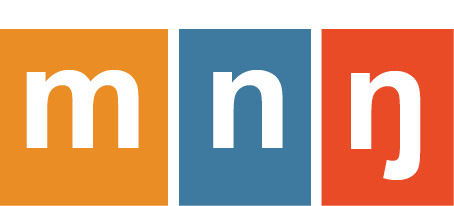
The Nasal Consonants: M, N and NG
Let’s learn to pronounce m, n, and ng. We study these sounds together because they are the three nasal consonants. You make them by sending air through your nose.
You Will Need Your Nose for This
To make these sounds, you completely block the air with your mouth, so the air goes through your nose. Try it! Hold your nose shut while you say the word man. You won’t be able to say it because the sound needs to come through your nose.
For m, block the air by closing your lips.
For n, block the air by putting your tongue on the roof of your mouth behind your front teeth (the alveolar ridge).
For ng, block the air by raising your tongue in the back of your mouth.
M, N, and NG Are Voiced Consonants
If a letter is “voiced,” that means you will use your vocal cords to make the sound. Since m, n, and ng are voiced sounds, you should be able to put your fingers on your neck and feel your vocal cords vibrate. You could also think of these nasal consonant sounds as “humming” sounds, as when you sing without words and without opening your mouth.
M, n, and ng are continuous sounds. This means that as long as you have breath, the sound can continue until you stop.
The “M” Sound
Almost all languages in the world have this sound. In English, the m sound is almost always pronounced, even at the end of a word.
Practice Pronouncing M
Pronounce these words with m from the book of John. Some words have the m sound at the beginning, some in the middle, and some at the end. Remember to always pronounce m clearly. If you have trouble, try making a humming sound with your mouth closed, then say the rest of the word.
Listen to the word, then repeat. Notice other parts of the pronunciation, too, like syllable stress and the way vowels are pronounced.
Practice these words with the “m” sound
made, met, messiah, human, temple, complete, someone, from, them, became
The “N” Sound
80% of the world’s languages have this sound, so this may be very easy for you. N is a humming sound that you make with your mouth slightly open but with the air blocked by your tongue touching the alveolar ridge behind your front teeth.
Be sure to completely pronounce n. Try not to say m or ng when you should say n. If you change the sounds by mistake, you could change the meaning of the word.
Try these words with the n sound. All these words are in the first chapter of John.
Practice these words with the “n” sound
never, named, nation, nature, darkness, sent, only, shines, children, born
The “NG” Sound
This sound may be more difficult for English learners. In different English accents, it may also be pronounced differently. You will want to listen carefully to learn how it is pronounced in the English accent you hear and speak the most.
Ng is a digraph, which means it is one sound spelled by two letters. Don’t say the n and the g sounds separately. These two letters produce one sound that is made when you push the back of your tongue up to the roof of your mouth, forcing the air to go up through your nose. Add the humming sound of your vocal cords to make this voiced sound.
Ng has its own IPA symbol – /ŋ/. Many words in English have this sound, because it is a common ending for continuous verbs, like am eating, was sleeping, etc. Practice these words with me:
Practice these words with the “ng” sound
eating, sleeping, sing, sang, song, sung
More about Ng
Ng will never be at the beginning of an English word. If you see ng in the middle of a word, it will probably be split into two syllables. First, pronounce the ng at the end of one syllable, then say a hard g sound to begin the next syllable. Look at these words:
Practice these words with “ng” in two syllables
English, En-glish, English
finger, fin-ger, finger
jungle, jun-gle, jungle
We will look at more ways to spell the ng sound in the spelling section. (coming soon)
3 Things to Remember about Nasal Consonants
These general rules will help you remember how to pronounce the nasal consonant sounds m, n, and ng:
- These sounds are always pronounced completely.
- They are rarely silent.
- Since the sound is made by sending air through your nose, use your tongue to prevent the air from going through your mouth. Be sure to put your tongue in the correct place so you say the word you want to say.
What Should I Practice Next?
We have a few more consonant pairs to learn, so let’s continue by learning the sounds of s and z. Click here to to go to that lesson now.
